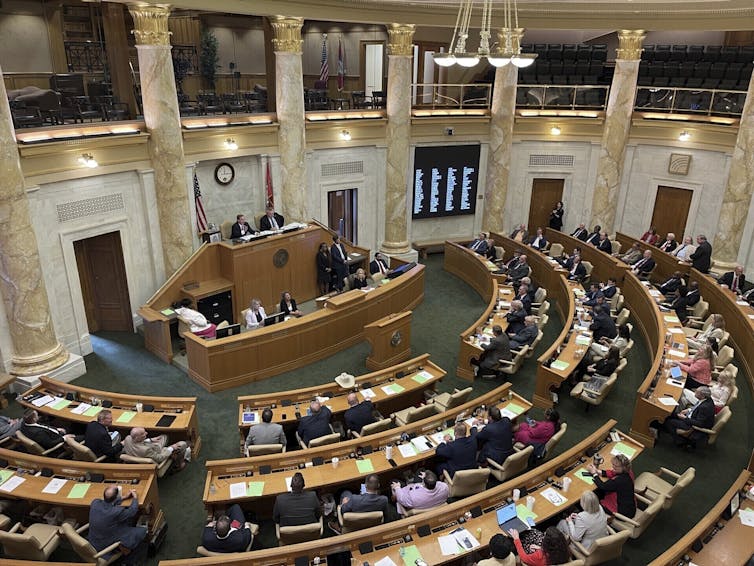Source: The Conversation – UK – By Audrey O’Grady, Associate Professor in Biology, University of Limerick

Imagine a mum who can have children from two different species. Family gatherings would be interesting, to say the least. In the insect world, this is no joke. A new study published in Nature shows that queens of the Iberian harvester ant (Messor ibericus) routinely lay eggs of not just to their own kind, but also of males of another species, Messor structor.
The researchers even coined a word for it, xenoparity, meaning “foreign birth”. It pushes the boundaries of what we mean by “species”. And this is the first known case in the animal kingdom of this happening as part of an animal’s life cycle.
The most typical reproduction strategy in the natural world involves a mother and father of the same species who breed and produce sons and daughters, also of the same species.
However, there are exceptions to the rule. Social insects, ants in particular, are known to violate it. A 1999 study found that 17 out of 164 central Europe ant species are known to create hybrid offspring.
Typically, in ant colonies, fertilised eggs develop into workers and queens and unfertilised eggs develop into males. All the ants that we usually see foraging are females who cannot reproduce (workers), but do all the other work. Ants that breed, female queens and males, normally have wings and can be seen during mating flights. Afterwards, males often die while the females found new colonies.
However, in some ant species, unfertilised eggs develop into female clones of the mother. This process is called parthenogenesis.
Generally, ant colonies which include different ant species may contain either one or several queens that can mate with either single or multiple males. Some ant species produce only wingless males that mate inside the nest and never participate in nuptial flights.
In 2002 an even more interesting reproduction strategy was found in two seed harvester ant species, common in southwestern US, whose queens lost their ability to produce female workers of their own kind. They need to mate with a male from a different species to lay eggs that develop into hybrid species female workers. This cross-species mating is essential for the survival of both species.
The new discovery
The article provides startling insights into ant reproduction. Workers (females) in these colonies are hybrids. Like the seed harvester ants, the Iberian harvester queens can’t make workers on their own. They need sperm from M. structor, and the daughters are half M. ibericus, half M. structor. This is similar to social hybridogenesis documented in other harvester ants, where only cross-species daughters become workers.
But the fascinating part is that Iberian harvester queens produce ordinary M. ibericus sons as well as M. structor sons. These males aren’t hybrids. They’re clones, carrying only their father’s DNA. Iberian harvester queens act almost like a rental womb. This resembles male-only cloning known from some clams and a stick insects.

Nick Greaves
The researchers sequenced the DNA of hundreds of Iberian harvester ants and repeatedly found this same pattern.
M. ibericus and M. structor split from a common ancestor millions of years ago. They look and behave differently in the wild, with M.ibericus having smaller queens. Yet one is now literally producing the other. Multiple colonies of M.ibericus live together in habitats ranging from pastures to suburban areas. But M.structor ants are a mountain species and their colonies live separately. The two ant species can live close together in overlapping habitats in lanes and fields near mountains.
The cloned M. structor sons raised inside M. ibericus colonies don’t just differ genetically, they even look odd. Compared with their wild cousins, they appear almost hairless.
The most probable explanation of how this reproduction strategy evolved is a phenomenon called sperm parasitism. This is when females of one species use sperm of the males of another species to stimulate asexual reproduction or even partially incorporate the male’s genome into their offspring.
Over time, they cut out the middleman (adult M.structor males) and started making their own supply of cloned M. structor males. Instead, they mate with these clones that hatch in the colony nest.
It shows that evolution can re-engineer reproduction in radical ways. People sometimes like to think nature follows straight paths. Parents make their own species. Colonies stick to one lineage.
But evolution doesn’t care about our rules. So the next time you see ants marching across a path, remember, somewhere in southern Europe, there’s a queen casually running a two-species household. And you thought your family tree was complicated.
![]()
The authors do not work for, consult, own shares in or receive funding from any company or organisation that would benefit from this article, and have disclosed no relevant affiliations beyond their academic appointment.
– ref. One queen ant, two species: the discovery that reshapes what ‘family’ means in nature – https://theconversation.com/one-queen-ant-two-species-the-discovery-that-reshapes-what-family-means-in-nature-264384
















